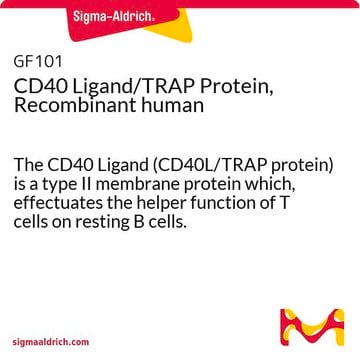H3274
Higromicina B from Streptomyces hygroscopicus
powder, non-animal origin, suitable for cell culture and insect cell culture, BioReagent
Sinónimos:
Hygromycin
About This Item
Productos recomendados
product name
Higromicina B from Streptomyces hygroscopicus, powder, BioReagent, suitable for cell culture, suitable for insect cell culture
biological source
Streptomyces hygroscopicus
Quality Level
product line
BioReagent
form
powder
concentration
≥60% (HPLC)
technique(s)
cell culture | insect: suitable
cell culture | mammalian: suitable
color
faintly brown to brown
white to beige
(1) 7.1, (2) 8.8
mp
160-180 °C
solubility
H2O: 50 mg/mL (As a stock solution. Stock solutions should be stored at 2-8°C. Stable at 37°C for 30 days.)
antibiotic activity spectrum
fungi
mode of action
protein synthesis | interferes
storage temp.
2-8°C
SMILES string
CN[C@H]1C[C@@H](N)[C@H](O)[C@@H](O[C@@H]2O[C@H](CO)[C@H](O)[C@@H]3O[C@]4(O[C@H]([C@H](N)CO)[C@H](O)[C@H](O)[C@H]4O)O[C@H]23)[C@@H]1O
InChI
1S/C20H37N3O13/c1-23-7-2-5(21)9(26)15(10(7)27)33-19-17-16(11(28)8(4-25)32-19)35-20(36-17)18(31)13(30)12(29)14(34-20)6(22)3-24/h5-19,23-31H,2-4,21-22H2,1H3/t5-,6-,7+,8-,9+,10-,11+,12-,13+,14-,15-,16+,17+,18-,19+,20+/m1/s1
InChI key
GRRNUXAQVGOGFE-XKIAHZFYSA-N
¿Está buscando productos similares? Visita Guía de comparación de productos
Categorías relacionadas
General description
Application
- células 293T transfectadas con mezcla de plásmidos a 160 μg/ml.
- células MCF-7ALOX12 a 150 μg/ml.
- plásmido MSCV Luciferasa PGK-higro.
- línea celular reportera HeLa estable STAT3 ( establemente transfectada con el gen de la luciferasa bajo el control del promotor STAT3) mantenida en DMEM complementado con FBS al 10%.
Biochem/physiol Actions
Espectro antimicrobiano: La higromicina B actúa contra bacterias, hongos y células eucariotas superiores.
Caution
Preparation Note
signalword
Danger
hcodes
Hazard Classifications
Acute Tox. 1 Inhalation - Acute Tox. 2 Dermal - Acute Tox. 2 Oral
Storage Class
6.1A - Combustible acute toxic Cat. 1 and 2 / very toxic hazardous materials
wgk_germany
WGK 3
flash_point_f
Not applicable
flash_point_c
Not applicable
Certificados de análisis (COA)
Busque Certificados de análisis (COA) introduciendo el número de lote del producto. Los números de lote se encuentran en la etiqueta del producto después de las palabras «Lot» o «Batch»
¿Ya tiene este producto?
Encuentre la documentación para los productos que ha comprado recientemente en la Biblioteca de documentos.
Los clientes también vieron
Artículos
Prevent fungal, yeast, and mold contamination in cell cultures. Discover the best antifungal agent for your cultures with the extensive Sigma® antifungal collection.
Prevent fungal, yeast, and mold contamination in cell cultures. Discover the best antifungal agent for your cultures with the extensive Sigma® antifungal collection.
Prevent fungal, yeast, and mold contamination in cell cultures. Discover the best antifungal agent for your cultures with the extensive Sigma® antifungal collection.
Prevent fungal, yeast, and mold contamination in cell cultures. Discover the best antifungal agent for your cultures with the extensive Sigma® antifungal collection.
Protocolos
Stem Cell protocols for cryopreservation, thawing of cryopreserved stem cells and media preparation.
Nuestro equipo de científicos tiene experiencia en todas las áreas de investigación: Ciencias de la vida, Ciencia de los materiales, Síntesis química, Cromatografía, Analítica y muchas otras.
Póngase en contacto con el Servicio técnico










